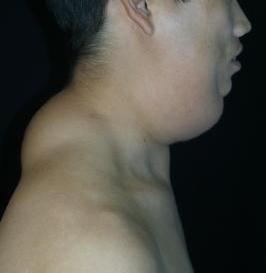Specialty endocrinology ICD-9-CM 272.8 MeSH D008069 | ICD-10 E88.8 (ILDS E88.820) OMIM 151800 | |
 | ||
Benign symmetric lipomatosis (also known as Benign symmetric lipomatosis of Launois–Bensaude, Madelung's disease, multiple symmetric lipomatosis, and cephalothoracic lipodystrophy) is a cutaneous condition characterized by extensive symmetric fat deposits in the head, neck, and shoulder girdle area. The German surgeon Otto Wilhelm Madelung was the first to give a detailed description of the disorder. This condition is very rare, with an estimated incidence rate of 1 in 25,000, and affects males up to 30 times more frequently than females.
The cause of the disease remains unknown, but its incidence strongly correlates with alcohol abuse; abstinence from alcohol prevents disease progression. Defects in the adrenergic-stimulated lipolysis and accumulation of embryological brown fat have also been reported. Cosmetic disfigurement due to the fat deposition in the cervicothoracic region results in a "pseudoathletic appearance", resembling the Italian statue Warrior of Capestrano and carvings of Queen of Punt (Egypt). Traditionally the treatment is mainly surgical, consisting of the removal of the lipomas, although recent study has proposed liposuction and phosphatidylcholine injection as possible alternatives.
In art and culture
The appearance of people with the disease is depicted in:
